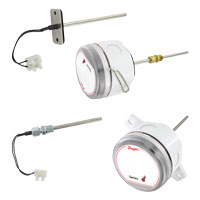 Air flow pressure switches and differential pressure switches work just like the light switches we have in our living rooms at home: when they are switched on, the switch makes contact, closes the circuit, and turns on. When they are switched off, the circuit is broken and power turns off. With air flow switches, instead of being manually switched, the air flow switch closes or opens the contact by reacting to changes in the air pressure at a pre-set actuation point, and turns on and off accordingly. These air pressure switches may be used to start/stop motors or fans, open/close dampers or louvers, sound alarms, and more. Continue reading “Let’s Chat About Air Pressure Switches!”
Air flow pressure switches and differential pressure switches work just like the light switches we have in our living rooms at home: when they are switched on, the switch makes contact, closes the circuit, and turns on. When they are switched off, the circuit is broken and power turns off. With air flow switches, instead of being manually switched, the air flow switch closes or opens the contact by reacting to changes in the air pressure at a pre-set actuation point, and turns on and off accordingly. These air pressure switches may be used to start/stop motors or fans, open/close dampers or louvers, sound alarms, and more. Continue reading “Let’s Chat About Air Pressure Switches!”
How to Choose a Proper Temperature Sensor

There are three main types of temperature sensors, and each one has its own strengths and weaknesses. Today we’ll be discussing the advantages/disadvantages of each RTD temperature sensors, thermistors, and thermocouples. Continue reading “How to Choose a Proper Temperature Sensor”
Hospitals: The Hot-Wired Anemometers That Keep Them Running Properly
 Hot-wire anemometers are often used in a hospital environment to measure and maintain room pressurization/de-pressurization. These applications require a positive pressure in operating rooms where bacteria cannot be allowed to enter, or a negative pressure in a quarantine environment to ensure that all bacteria will stay within the room. Continue reading “Hospitals: The Hot-Wired Anemometers That Keep Them Running Properly”
Hot-wire anemometers are often used in a hospital environment to measure and maintain room pressurization/de-pressurization. These applications require a positive pressure in operating rooms where bacteria cannot be allowed to enter, or a negative pressure in a quarantine environment to ensure that all bacteria will stay within the room. Continue reading “Hospitals: The Hot-Wired Anemometers That Keep Them Running Properly”
Ask the Expert – Magnehelic® Gage with Low Temperature Option

Question: Can the Magnehelic® Differential Pressure Gage handle a temperature of -10°F? Continue reading “Ask the Expert – Magnehelic® Gage with Low Temperature Option”
Capacitance Polymer Humidity Sensors
 Humidity sensors are one of the most common types of sensors used for HVAC equipment and building management systems. With proper humidity monitoring, energy efficiency of a building can be improved. By using environmental conditions in conjunction with an economizer to reduce the building load, cool outside air is used to cool the indoor space of a building. Dampers, humidity sensors, and temperature sensors are used to verify optimal outdoor conditions for maximizing energy cost savings. Continue reading “Capacitance Polymer Humidity Sensors”
Humidity sensors are one of the most common types of sensors used for HVAC equipment and building management systems. With proper humidity monitoring, energy efficiency of a building can be improved. By using environmental conditions in conjunction with an economizer to reduce the building load, cool outside air is used to cool the indoor space of a building. Dampers, humidity sensors, and temperature sensors are used to verify optimal outdoor conditions for maximizing energy cost savings. Continue reading “Capacitance Polymer Humidity Sensors”





